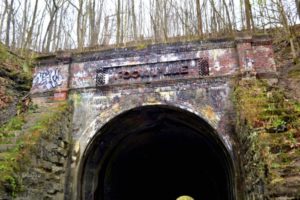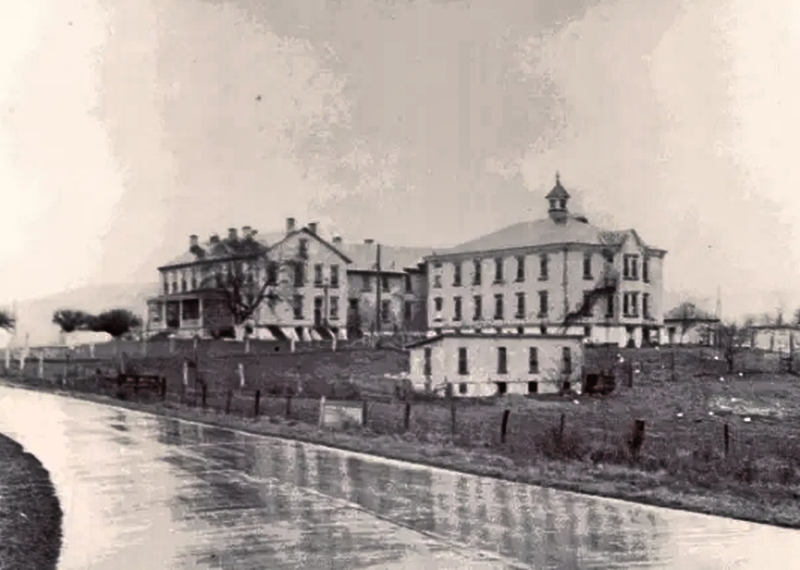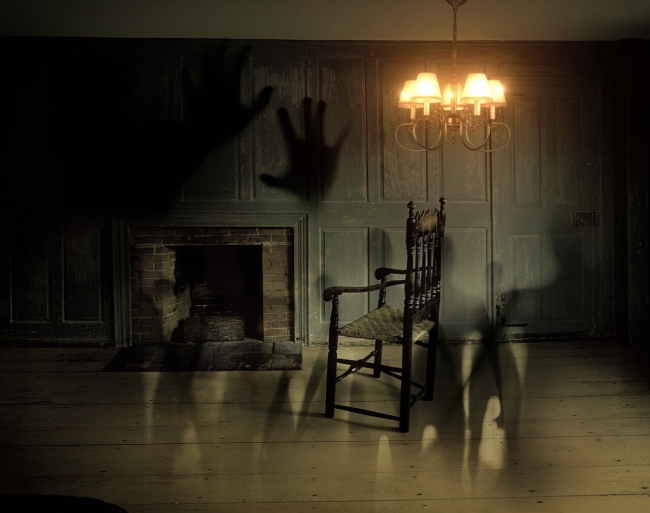We’re continuing our ghostly series of Appalachian Hauntings. Enjoy the journey!
Ohio
Moonville Tunnel — Vinton County

Background:
Moonville was a mining town back in the day, located just near the Maryville and Cincinnati (M&C) Railroad. The town began after a man named Samuel Coe made a deal with the railroad company. The Maryville and Cincinnati built the railroad on his property. In exchange, Coe used the railroad to haul coal and other resources off his land. People came from all over to work in Coe’s mines. Consequently, Moonville was established.
The town only had a population of about 50 to 65 people at most, with a schoolhouse, post office, general store, and a railroad depot. Unlike many coal towns, Moonville had houses “sparsly [sic] scattered about the area.”1)Moeckel, Rich. 2001. “The Moonville Ghost Tunnel.” Internet Archive. May 28. The tracks provided the perfect thoroughfare for people who wanted to avoid arduous hills (or wanted a quick, even path to the saloon). The last inhabitants left in 1947. Today, all that remains of Moonville are some foundations, the cemetery, old tracks, and the tunnel.
The tunnel stretches 50 to 100 yards (depending on the source) and was “originally made by stone cutters from huge sandstone blocks.” The railroad rebuilt the passage in the early 1900s with brick to cut costs. The tunnel was built quite narrow and trains hit full speed straight through.2)DePeel, Kirk. 2001. “Ghosts of Moonville.” spikesys.com. May 23. Additionally, Moonville had four long trestles laid precisely the width of the track.3)DePeel, Kirk. 2001. “Ghosts of Moonville.” spikesys.com. May 23. A person in the way of an oncoming train had two options: jump to “an almost certain death”4)DePeel, Kirk. 2001. “Ghosts of Moonville.” spikesys.com. May 23. or be hit by the train. Several people died on these trestles and in the tunnel.
Paranormal experiences:
- Two ghosts reportedly roam the area. The first is a headless man who strolls around waving a lantern inside the tunnel,5)Moeckel, Rich. 2001. “The Moonville Ghost Tunnel.” Internet Archive. May 28. likely to warn an oncoming train. He was reportedly a train conductor who fell and was decapitated. People have encountered him as far back as the 1890s.
- Another story says the conductor was having an affair with a coworker’s wife and was “pushed out of the train and ran over.”6)Moeckel, Rich. 2001. “The Moonville Ghost Tunnel.” Internet Archive. May 28. In 1981, the railroad installed a signal at Moonville because too many engineers saw the lantern and operated their emergency brakes.
- The other ghost is a woman in a blue-ish nightgown who wanders the tracks at night. One report says she was a young woman hit by a train on her way to see her lover.
- Other witnesses said the woman is in her 40s and wears clothing from the 19th century. She is purportedly a solid figure. One witness spoke to her and she turned and locked eyes as she walked away.
- Some people claim to have heard screams inside the tunnel.
Eerie Factor: ![]()
![]()
![]()
![]()
My mother lived in a coal camp her entire childhood (Westbourne). When I was younger, she took the family to visit the spot and I was so disappointed to see it completely razed. She pointed out where houses or structures used to be. All I saw was a vast land of briars and bushes. In broad daylight, the silence and desolation gave me a creepy sensation. Add a dark tunnel to that and a few deadly train trestles and it would certainly be eerie — especially at night.
Danger Factor: Low
Though people may have died on the Moonville tracks or in the tunnel, no reports of dangerous beings have been documented.
Gallery:
![]()
Pennsylvania
Greene County Poorhouse
(aka Greene County Poor Farm, aka Green County Almshouse)

Background:
In 1857, a family by the name of Rhinehart built a farm in Greene County, Pennsylvania. The land was blood-stained from the start through a series of brutal battles between the Rhineharts and the Native Americans. In 1861, Greene County acquired the land, along with the Rhineharts’ Georgian Revival-style, 12-room farmhouse. The location was deemed perfect for a poorhouse. The county began additions straightaway. The poorhouse director lived in the “original” Rhinehart house while the poor were housed in the newly built two-story wing.7)Asylum Projects. Updated 2020. “Greene County Almshouse.” Asylum Projects. June 30.
Pennsylvania had passed the Pennsylvania Poor Law in 1705, employing administrators to “collect taxes to subsidize care of the poor.”8)The Pennsylvania Poor Law also authorized these overseers “to outsource poor children as apprentices or indentured servants.” Poor people were discouraged at every turn. They even had to wear a red or blue letter P, indicating they were poor or a “pauper.” (info from Stephanie Hoover) Communities realized they needed to house the indigent and those who could not work. Poorhouses were then erected throughout the United States. So, by the 1860s, just about every Pennsylvania county had a poorhouse.9)In 1883, laws were passed for children to be removed from poorhouses and sent to foster homes or other facilities for children. In 1915, the first worker’s compensation was in effect and this curbed much of the poorhouse population.
Residents were treated especially well and life went smoothly for the director until the facility reached excessive numbers. Those numbers steadily rose even after another wing was added in 1886.10)Asylum Projects. Updated 2020. “Greene County Almshouse.” Asylum Projects. June 30.11)The addition in 1886 allowed the construction of a large dining hall. Further, the facility had gradually become more like a small psychiatric hospital.12)Greene County Historical Society. n.d. “Paranormal.” Greene County Historical Society. Accessed Nov 2021. Though the directors and the medical community had good intentions, they administered cruel treatment by today’s standards. Plus, the poorhouse was ill-equipped to house mentally ill persons. Stir a little overcrowding and mental health illness inside a hot cauldron with a giant spoon of no public monies and abuse appears on the menu.13)In the 1880s, the mentally ill were removed from the Greene County Poorhouse.
The Greene County Poorhouse saw a series of directors and stewards come and go. Most all these men and their families were kind and compassionate. But, as we all know, a rotten potato makes the whole bag stink. William B. Cage became the poorhouse director (not sure about the exact date of his hiring). Cage was a rotten potato. Sources say he was heartless and “sadistic.”14)Asylum Projects. Updated 2020. “Greene County Almshouse.” Asylum Projects. June 30. Newspapers at the time published articles regarding Cage’s inhumane treatment. The website Asylum Projects quotes an 1890 article in The Waynesburg Republican:
He was known to use the food set aside for the residents to throw lavish parties in the “front of the house” – or the stewards residence – while leaving only scraps and leftovers for the inmates, he was accused of chaining individuals up in the basement rooms of the newest wing and allowing them to starve as punishment for minor infractions, and forcing the residents to bath [sic] in the creek behind the poorhouse in the icy cold winter months. He was known to have a cane with which he commonly beat the residents. It was even reported that Cage staffed the kitchen with a head cook who was blind, and that as a result the food consumed by the inmates was generally undercooked, and filled with flies. 15)Shackles reportedly still remain in the basements where some “inmates were chained.” (info from Journeys into the Supernatural website)
Cage was removed from his position sometime in the 1900s, after which conditions greatly improved. In the 1960s, the building was a retirement home. In 1971, the Greene County Historical Society obtained the structure, which houses their information and a museum. The museum has “room after room of historical riches” and period furniture, clothing, and musical instruments.
The structure boasts over 32,000 square feet and once served more than 6,000 residents. Sadly, over 1,000 deaths occurred there.16)Journeys into the Supernatural. unknown year. “Greene County Poor Farm.” Journeys into the Supernatural. Mar 6.
Paranormal Experiences:
- A previous board member was in the back of the building one day and heard moaning. He investigated but found no one there.17)Hoover, Stephanie. 2017. “Pennsylvania Poorhouses: Their History and Records.” PennsylvaniaResearch.com.
- Unexplained people have been seen walking around in 19th century garb.
- The Historical Society staff has heard voices and seen shadow figures.
- Objects mysteriously disappear to be found in other places.
- People have seen a little red-haired boy.
- Someone “in green fatigues” was seen in the library.18)Hoover, Stephanie. 2017. “Pennsylvania Poorhouses: Their History and Records.” PennsylvaniaResearch.com.
- The sound of boxes moving around was heard by a staff member who was alone in the building. The person investigated but found no one in the house.19)Hoover, Stephanie. 2017. “Pennsylvania Poorhouses: Their History and Records.” PennsylvaniaResearch.com.
- Disembodied footsteps have been heard.
- Strange smells and unexplained sounds have been experienced.
- Lights flicker on and off
- The activity was so frequent that the Greene County Historical Society requested a paranormal investigation. The Western Pennsylvania Paranormal Hunters conducted an investigation and found the area was haunted.
Eerie Factor: ![]()
![]()
![]()
The building is currently filled with the Greene County Historical Society’s documents and museum artifacts. From the sources I read, the visits are pleasant and educational. Paranormal experiences and sightings have been recorded. Yet, if the building were abandoned, the Eerie Factor would warrant five ghosts.
Danger Factor: Low to Medium
No evidence of malicious behavior by the spirits has been reported or documented. The activity, however, appears to occur frequently.
Gallery:
These videos about the above hauntings may interest you.
** Featured image by Mysticsartdesign on Pixabay
References
| ↑1, ↑5, ↑6 | Moeckel, Rich. 2001. “The Moonville Ghost Tunnel.” Internet Archive. May 28. |
|---|---|
| ↑2, ↑3, ↑4 | DePeel, Kirk. 2001. “Ghosts of Moonville.” spikesys.com. May 23. |
| ↑7, ↑10, ↑14 | Asylum Projects. Updated 2020. “Greene County Almshouse.” Asylum Projects. June 30. |
| ↑8 | The Pennsylvania Poor Law also authorized these overseers “to outsource poor children as apprentices or indentured servants.” Poor people were discouraged at every turn. They even had to wear a red or blue letter P, indicating they were poor or a “pauper.” (info from Stephanie Hoover) |
| ↑9 | In 1883, laws were passed for children to be removed from poorhouses and sent to foster homes or other facilities for children. In 1915, the first worker’s compensation was in effect and this curbed much of the poorhouse population. |
| ↑11 | The addition in 1886 allowed the construction of a large dining hall. |
| ↑12 | Greene County Historical Society. n.d. “Paranormal.” Greene County Historical Society. Accessed Nov 2021. |
| ↑13 | In the 1880s, the mentally ill were removed from the Greene County Poorhouse. |
| ↑15 | Shackles reportedly still remain in the basements where some “inmates were chained.” (info from Journeys into the Supernatural website) |
| ↑16 | Journeys into the Supernatural. unknown year. “Greene County Poor Farm.” Journeys into the Supernatural. Mar 6. |
| ↑17, ↑18, ↑19 | Hoover, Stephanie. 2017. “Pennsylvania Poorhouses: Their History and Records.” PennsylvaniaResearch.com. |









